
3.1 DATABASE
3.1.1
PREVI has its own reference file for participants in the PREVI Futuro Benefit Plan, which is integrated to the Entity’s other information systems. To compose this reference file, we receive financial and non-financial information (personal and functional data) from the Banco do Brasil and from the available database. The data is treated carefully, and submitted to consistency and reliability filters.
3.1.2
The reference file database that is used for the actuarial appraisal of Benefit Plan 1 dates to December 2009. The registrations of 58 active participants were rejected, representing 0.1% of the database. The reference file’s summary presents the following numbers regarding active participants, assisted participants and pensioners
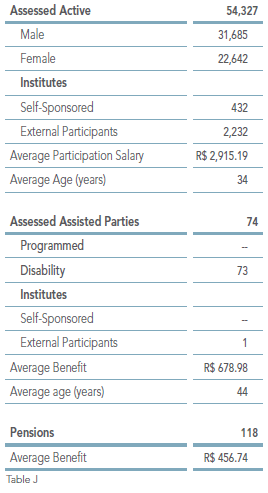
3.2 BENEFIT PLAN
3.2.1
On account of CGPC Resolution n. 16, of 11/22/2005, and of SPC Normative Instruction n. 9, of 01/17/2006, the PREVI Futuro Benefit Plan is defined as one of Variable Contribution, and is composed of Part 1, outlined in the defined benefit mode, including the following benefits as set forth by the Regulation:
- Retirement supplement for disability;
- Pension supplement for death.
3.2.2
Part II, outlined in the variable contribution mode, presents the following benefits as set forth by the Regulation:
- Monthly Retirement Income;
- Monthly Early Retirement Income;
- Monthly Pension Income for Death.
3.3 CALCULATION METHODOLOGY AND ACTUARIAL PREMISES
3.3.1
The PREVI Futuro Benefit Plan is appraised based on the capitalization system for all installment-based payment benefits that are scheduled and continuous. Regular and early retirements are included in this type.
3.3.2
The aggregated method was used to calculate the disability and pension for death charges for Part I. The principle of asset financial accumulation is used for the generation of the monthly retirement income or the monthly early retirement income for Part II.
3.3.3
The premises used in the December 2009 actuarial reappraisal for the 2010 fiscal year were approved by the Executive Board and by the Deliberative Body. The approved premises were:
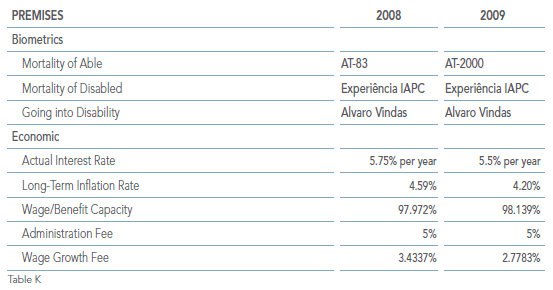
3.3.4
When comparing the current premises to those of the previous year, we notice there were changes regarding the mortality table, actual interest rate, wage and benefit capacity, and actual wage growth rate.
3.3.5
The mortality table changed due to a study conducted by PREVI’s actuarial area which showed that the average life expectancy of PREVI participants has increased in the last years. By analyzing mortality rates, life expectancy, and results of statistical tests, we verified that the PREVI population is best represented by mortality table AT-2000.
3.3.6
Considering that the prospective method is used for calculating the mathematical reserve, according to which commitments and future plan contributions are calculated in current values, the use of table AT-2000 proves to be more appropriate.
3.3.7
The actual interest rate decreased from 5.75% to 5.5% based on the macroeconomic scenario that subsidized the 2010-2016 Investment Policy.
3.3.8
The capacity factor increased from 97.972% to 98.139% due to a change in scenario regarding the long-term inflation rate.
3.3.9
The wage growth rate, which reflects the projection of the active participants’ wages when they start receiving the benefit, was changed from 3.4337% to 2.7783%, as per a report prepared by the sponsor.
3.3.10
Therefore, the change of actuarial premises for the 2010 fiscal year, evaluated separately, lead to a reduction of the Mathematical Reserve of R$ 43.9 million.
3.4 FINANCIAL AND ACTUARIAL STATUS
The actuarial appraisal of the social security commitments taken-on by the plan on 12/31/2009, as well as its Net Assets, produced the following results:
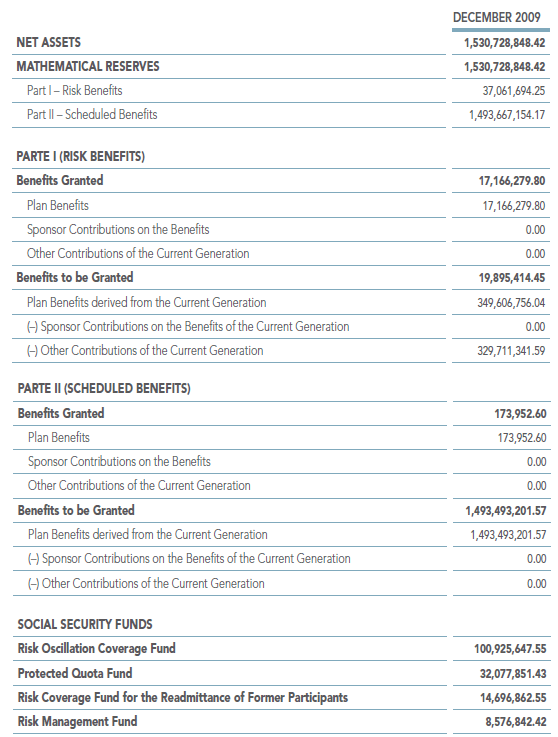
Table L – Value in Brazilian Real (R$)
3.4.2
There was significant variation in the technical result throughout the fiscal year due to the variable income asset performance in 2009 and the modification of actuarial premises mentioned in item 3.3.9.
3.4.3
The following graphic illustrates the development of Mathematical Provisions and Net Assets of the plan during the last three fiscal years:
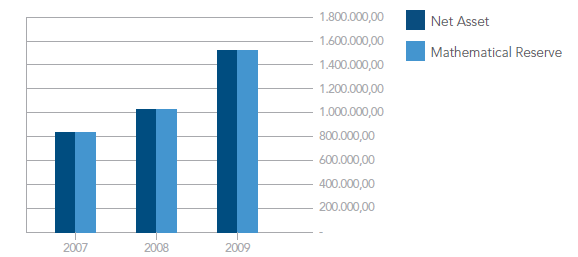
3.5 SOCIAL SECURITY FUNDS
3.5.1
The following Social Security Funds were created in October 2006, after adjustments were made to processes and systems, and appropriate amounts were allocated to them:
- Protected Quota Fund: relative to resources that do not have destinations specified for them in the current regulation, e.g. for participants who left the Plan and are no longer hired by the Bank, remaining with the employer’s part relative to Part II of the Plan since there is no destination for them in the regulation in effect. There are also resources related to the redemption of personal contributions made by participants who left the Plan but remain hired by the Bank.
- Fund to Cover Risks for the Readmittance of Former Participants: relative to the amounts that are necessary to recompose the employer’s balance for Part II for participants who left the Plan, but remained hired and, thus, can return to it, with such right being acknowledged by the Plan’s regulation.
- Risk Management Fund: constituted to face commitment oscillations and operating adjustments made to the Plan.
3.5.2
There is also a Risk Oscillation Coverage Fund, constituted in December 2005 to be used whenever there is a reduction in the amount of the PREVI Payment – PP. On 12/31/2009, R$ 51,712,899.54 were added to complement the estimated cost of implementing the new PP.
3.6 FUNDING PLAN
3.6.1
The Funding Plan determines the contribution level that is required to fund the plan’s benefits according to the financial system and the funding method in order to maintain the plan’s balance and solvency.
3.6.2
The PREVI Futuro Benefit Plan is funded by the monthly and annual contributions made by the participants and by the sponsor, as listed in Table M.
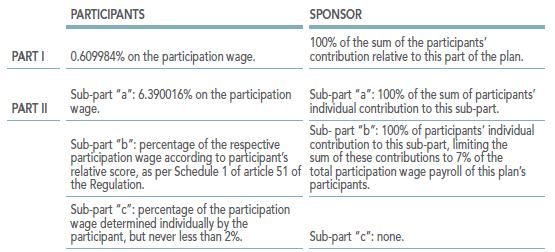
Table M – Obs.: The Sponsor’s total contribution to the Plan PREVI Futuro is
limited to 14% of the total participation wage payroll.
3.7 ADDITIONAL CONSIDERATIONS
3.7.1
Before the reversal of the Risk Management Fund, the calculation of the Plan’s results on 12/31/2009 showed a technical surplus of R$ 51,712,899.54. Two factors greatly influenced this result: the Plan’s 27.14% positive profitability variation in 2009 and the alteration of actuarial premises, as per mentioned in item 3.3.9.
3.7.2
The number of assets appraised in the actuarial calculation rose from 50,376 (December/2008) to 54,385 (December/2009), a 7.96% increase derived from the significant amount of enrollments to the Plan by employees who were hired by Banco do Brasil during 2009. The inclusion of this new group of participants formed, on average, by young people with early career wages, had a positive impact on the Plan’s results.
3.7.3
In June 2006, benefits were granted to an integral external participant that had implemented the conditions for receiving a monthly retirement income. The actuarial liability concerning this assisted participant is calculated in the mathematical reserve of granted benefits. During the concession period, the benefit was calculated considering the premises of actuarial reevaluation of 12/31/2005, i.e., with an interest rate of 6% and mortality table GAM-83 (20%).
3.7.4
During the benefit payment period, premises changed regarding interest rates and mortality table, which impacted the mathematical reserve amount calculated for this assisted participant. In December 2009, the difference between the balance of shares converted into Brazilian Real and the mathematical reserve of the retired participant generated a negative result of R$ 19,099.20, representing 10.98% of this mathematical reserve.
3.7.5
The Regulation of Benefit Plans Previ Futuro states in article 65 that if Part II of this plan ever presents a technical deficit, it will be covered exclusively by its participants receiving benefits and beneficiaries of Monthly Income Pension by Death.
3.7.6
However, we understood that the result derives from conjectural factors, such as the adoption of Mortality Table AT-2000 and a 5.5% interest rate, in addition to the participant being the only one in the Plan receiving benefits regarding Part II.
3.7.7
We moreover believe that, as the retired group increases, the possibility of actuarial gains may balance out this part of the plan. It is worth noting that the profitability of resources that assure this reserve of granted benefits tends to generate enough cash flow to honor its fiscal year commitments.
3.7.8
Given that the difference between the percentage reported in item 3.7.4 and the provisions of paragraph 1 of article 28 of CGPC Resolution 26/2008 is 0.98%, we conclude that there are no grounds for equating the negative result R$ 19,099.20 and it can wait for next year's actuarial valuation.
3.8 CONCLUSION
3.8.1
The results calculated for the Mathematical Reserves after the adjustments that were made to guarantee the coverage of the commitments the Plan took-on allowed the Plan’s technical balance to be reestablished.
3.8.2
We attest that the risk rate employed is sufficient to cover the risk benefits of the Benefit Plan.
3.8.3
We therefore evaluate that maintaining the Funding Plan to preserve the balance of the plan and thus assure that participants retire with a benefit that is compatible to their compensation is a satisfactory measure.
3.8.4
We suggest, during the 2010 fiscal year, studying the possibility of reducing the PREVI Part by using resources from the Risk Oscillation Coverage Fund to cope with the increase in actuarial liability.
